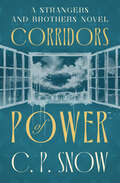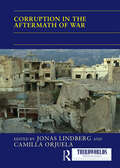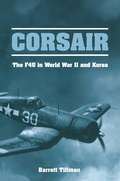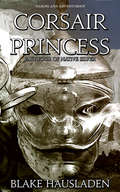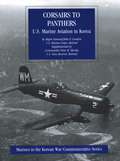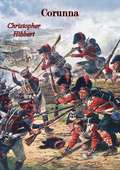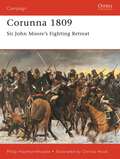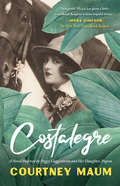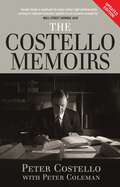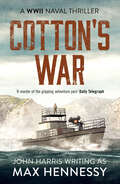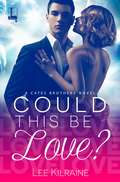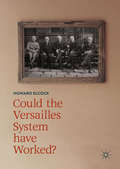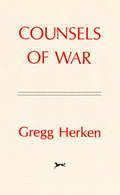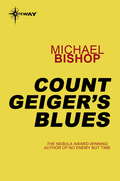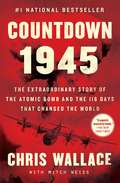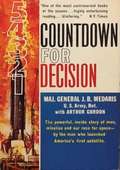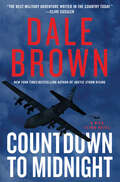- Table View
- List View
Corridors of Power (The Strangers and Brothers Novels)
by C.P. SnowThis novel of 1950s Britain offers &“a sound reading of the political, moral, ideological temper of the times; a substantial achievement&” (Kirkus Reviews). An ambitious MP and cabinet minister, Roger Quaife has strong opinions about the nuclear arms race that&’s been escalating in the postwar era. Lewis Eliot agrees with him on the issue, despite the hostile reaction Quaife&’s position has received. But Quaife has also been having an extramarital affair—and when the threat of blackmail looms, Eliot is faced with a difficult choice, in this thought-provoking novel, part of a series that &“presents a vivid portrait of British academic, political and public life&” (Jeffrey Archer, The Guardian). &“A master craftsman in fiction.&” —The New York Times &“An extremely shrewd observer of men and society.&” —Commentary
Corruption in the Aftermath of War (ISSN)
by Jonas Lindberg and Camilla OrjuelaCorruption is a serious concern, one which can undermine state legitimacy, exacerbate inequality, and affect trust between social groups. Such effects are particularly problematic in societies that have gone through violent conflict, and are struggling to rebuild institutions, restore social trust, and recover economically. While anti-corruption measures are increasingly integrated into post-conflict programs, war-time structures and practices of corruption often prevail. This book explores corruption in post-war societies by focusing on the important issues of power, inequality and trust. To understand post-war power structures, and the extent to which they engrain, challenge, or transform corrupt practices, we need to study what kind of peace has emerged. The empirical cases in this book offer a variety of post-conflict situations, demonstrating how corruption is played out in, depending on the type and extent of international intervention, and in the case of a victor’s peace, a contested peace, a partial peace etc. The chapters illustrate the experiences and perceptions of people on the ground in post-conflict societies, and by giving much space to local dynamics, the book shifts the focus from external intervention and actors to local contexts, striving for greater understanding of the interplay between corruption, power, inequality, and trust in post-war societies. This book was originally published as a special issue of Third World Quarterly.
Corsair
by Barrett TillmanThis is the remarkable story of an airplane that became a legend--with a sleek silhouette and bent wings, it doubled as a day and night fighter, could fly off carriers or from land, and served both as a dive bomber and reconnaissance plane. Filled with facts and figures, this fast-paced history begins with the nerve-wracking test flights of the 1940s and concludes with the F4Us that were active thirty-eight years later. Placed skillfully in between are the stories that gave birth to the legend: the exploits of the aces, including the Medal of Honor recipient who shot down twenty-five enemy planes, and the details of the combat missions of Charles A. Lindbergh. During thirty months of combat in World War II with the U.S. Navy and Marines, the Corsair shot down more than two thousand Japanese planes. In Korea the U-bird, as it was called, was credited with ten aerial victories.A trip down memory lane for anyone who has followed the career of this Cadillac of the props, this new paperback edition of a book first published in hardcover in 1979 offers fine historical aviation reading that presents a riveting picture of the men and machine that helped win two wars.
Corsair Princess (Native Silver #4)
by Blake Hausladen“WOW,WOW,WOW,WOW.....is all I can say about this book. Ghosts In The Yew was a great book; however Native Silver was on a whole different level.” - Kyle, GoodreadsThis novella is part four of Native Silver, also available as a collection.You can read the trilogy in full volumes, or broken up into five novellas each.The Vestal SeriesDruids are born by the innocence of children. Barok must come up with a new way to save Enhedu. A new Vesteal is born.And a daring corsair challenges all the East.“We had found the home of the druids, but Barok was ruined.”- Geart Goib (Chapter 60, Native Silver)The Vestal SeriesA tale of violent magic, intrigue, and statecraft, the Vesteal Series is the story of four souls that are banished beyond the edge of the map to a land of gnarled forests, ancient magic, and the site of a terrible murder. Their struggles to survive will put them at odds with their families, their nation, and the very powers that shaped the world.1. Ghosts in the Yew Novella 1 - Beyond the Edge Novella 2 - Opposing Oaths Novella 3 - Reckless Borders Novella 4 - Bayen's Women Novella 5 - Falling Tides2. Native Silver Novella 1 - Sutler's Road Novella 2 - Forgotten Stairs Novella 3 - Thrall's Wine Novella 4 - Corsair Princess Novella 5 - Tanayon Born 3. The Vastness Novella 1 - Silent Rebellion Novella 2 - The River War Novella 3 - The Blinded Novella 4 - Crimson Valley Novella 5 - Singer's Reward
Corsairs To Panthers: U.S. Marine Aviation In Korea [Illustrated Edition] (Marines In The Korean War Commemorative Series #1)
by Major-General John P. Condon USMC Commander Peter B. Mersky USNIncludes over 30 photos, maps and plans.The first major surprise of the post-World War II years came into play when in late June 1950, the United States found itself responding in crisis fashion to the North Korean invasion of the new republic of South Korea, just four years and nine months after VJ-Day. The nation became involved in Korea as a result of the Cairo and Yalta conferences in which the United States and the Soviet Union agreed to the concept of a free and independent post-war Korea.This is the story of the Marines who took to the sky above Korea, fulfilling many different missions including interdiction, night interception, close air support and tank busting. This memorial volume, richly illustrated, is a fitting monument to their courage and service.
Corunna (Great Battles Ser.)
by Christopher Hibbert‘Not a drum was heard, not a funeral note,As his corse to the rampart we hurried.’—from ‘The Burial of Sir John Moore at Corunna’ by Charles WolfeOne of the best remembered poems in the English language has served to keep alive the memory of Sir John Moore and of his burial at Corunna on 17 January, 1809. The story of the battle which he fought on the previous day and of the short campaign and horrifying retreat which preceded it is, however, not so well known.The Battle of Corunna saved a British army from annihilation and resulted in the tragic death of one of England’s finest generals. Setting out from Lisbon in the autumn of 1808, Sir John Moore had marched his army into Spain against Napoleon and by a daring manoeuvre had thrown it across the line of French communications. But, having thus drawn off Napoleon’s army from Madrid, Moore found himself so outnumbered and with no hope of assistance from the ineffectual Spanish armies, that he decided to withdraw to the coast. After a 250-mile retreat across the mountains of Galicia under appalling weather conditions, with inadequate food supplies and the French hard on his heels, he eventually reached the port of Corunna. Here he turned and drew up his depleted forces to face Marshal Soult’s massive army; and, though mortally wounded in the ensuing battle, he lived long enough to learn that the French had been checked and that his own army would be able to embark in safety.In Corunna extensive use is made of the many eyewitness accounts which survive in the form of official despatches, histories, diaries, memoirs and letters. With the aid of these, Christopher Hibbert not only shows a remarkable understanding of John Moore and his fellow officers, of their conflicting characters and views, but also provides a horrifying picture of the hardships of this brief and bitter campaign.
Corunna 1809
by Christa Hook Philip HaythornthwaiteThe retreat to Corunna is one of the epic campaigns of the Napoleonic Wars (1799-1815). Late in 1808 Sir John Moore found himself virtually alone with his small British army deep inside Spain. The armies of his Spanish allies had been overwhelmed and he faced a victorious French force under the Emperor Napoleon. He had little option but to order a retreat to the port of Corunna. This became the most arduous of trials with armies traversing mountainous terrain over appalling roads in the depths of winter. Somehow Moore held his outnumbered, exhausted men together as they struggled to reach safety. Finally at Corunna Moore's army turned to face its tormentors.
Cosmo's Tale
by Bennett Cole"I'm gonna die," screams Cosmo, a failed Navy parachute streaming behind him as his body hurtles earthward. Yet he survives. How? Was his unlikely birth in an Italian farmer's field in 1922 an omen of the untoward circumstances that would later characterize his life? Ministered to in the critical moments of his life by a mysterious "spooky" lady, Cosmo stumbles through countless storms of life: forced to fight with the Italian Army in WW II against his fellow Americans, gut-wrenching failed romances, a daring escape from a Guatemalan jail, and more. In spite of it all, Cosmo experiences a meteoric rise through the ranks of corporate management. Later, as a widower in his eighties and living on a coastal island, he miraculously survives a storm-of-the-century hurricane, and his spooky lady makes an incredibly peculiar final appearance.
Costalegre
by Courtney MaumIt is 1937, and Europe is on the brink of war. In the haute-bohemian circles of Austria, Germany, and Paris, Hitler is circulating a most-wanted list of “cultural degenerates”—artists, writers, and thinkers whose work is deemed antithetical to the new regime. <P><P>To prevent the destruction of her favorite art (and artists), the impetuous American heiress and modern art collector, Leonora Calaway, begins chartering boats and planes for an elite group of surrealists to Costalegre, a mysterious resort in the Mexican jungle, where she has a home. <P><P>The story of what happens to these artists when they reach their destination is told from the point of view of Lara, Leonora’s neglected 15-year-old daughter, who has been pulled out of school to follow her mother to Mexico. Forced from a young age to cohabit with her mother’s eccentric whims, tortured lovers, and entourage of gold-diggers, Lara suffers from emotional, educational, and geographical instability that a Mexican sojourn with surrealists isn’t going to help. But when she meets the outcast Dadaist sculptor Jack Klinger, a much older man who has already been living in Costalegre for some time, Lara thinks she might have found the love and understanding she so badly craves. <P><P>Sinuous and striking, heartbreaking and strange, Costalegre is heavily inspired by the real-life relationship between the heiress Peggy Guggenheim and her daughter, Pegeen. Acclaimed author Courtney Maum triumphs with this wildly imaginative and curiously touching story of a privileged teenager who has everything a girl could wish for—except for a mother who loves her back.
Costello Memoirs
by Peter Coleman Peter CostelloIn a political career spanning more than eighteen years, Peter Costello, Australia's longest serving Treasurer, steered the Government through some of its greatest economic and political challenges, paying off Government debt, introducing the GST and fighting five elections. The Costello Memoirs charts the victories and defeats in one man's very public life.
Cotton's War (The WWII Naval Thrillers)
by Max HennessyOne man stands in the way of an army in this relentless wartime thriller from &“a master of the gripping adventure yarn&” (The Daily Telegraph). Storming their way through Europe, the Nazis forces have made their way east to the Mediterranean, and are almost sure to conquer Greece. But they didn&’t bargain on coming up against Michael Anthony Cotton, a heroic marine who smuggles weapons and money to the Greek Resistance. As the conflict reaches a fever pitch, Cotton must venture on one last lethal mission, involving guns and high-speed pursuits, if he is to protect his homeland from the invading force. An unforgettable, action-packed thriller set against the dazzle of the Aegean, perfect for fans of Alexander Fullerton, Alan Evans and Antony Trew.
Could This Be Love?
by Lee KilraineEveryone in Climax, North Carolina, knows the Cates brothers. But Sijan Cates is famous far beyond his quaint hometown--and when he comes back, he brings trouble with him... Avery Danford urgently needs to get back in touch with her estranged family. If only she could get her picture in the papers, maybe they'd track her down...and what better way to accomplish that than to squeeze into the world's tightest dress and cozy up to the world's hottest actor, Sijan Cates? It's a crazy idea, but it just might work. And though the former actress has sworn off Hollywood hunks, she's got to admit this desperate measure might be a pleasure...Scandal-plagued Sijan has come home for some peace and quiet--and to stay out of the tabloids. Then a woman claiming to be his number-one fan plants a hot kiss on him--in front of a pack of paparazzi. There's only one way to protect his reputation: tell the world they're engaged. It's all just a show, as they use each other to get what they need. But in this sleepy Southern town, love stories have a way of coming true...
Could the Versailles System have Worked?
by Howard ElcockThis book explores the significance of the post-First World War peace settlement negotiated at Versailles in 1919. Versailles has always been a controversial subject and it has long been contended that the Treaty imposed unnecessarily severe conditions upon the defeated nations, particularly Germany, and in large part can be held responsible for the outbreak of war in 1939. This book considers the critical question as to whether the Treaty of Versailles established a new international settlement that could produce a peaceful and prosperous Europe, something that many have alleged was impossible. In an exhaustive analysis of the events that followed the Paris Peace Conference, Howard Elcock argues that the Versailles Treaty created a more stable diplomatic framework than has commonly been recognised, and challenges the traditional understanding that the delegates at Versailles can be held responsible for the failure to secure long-term peace in Europe.
Counsels of War
by Gregg F. HerkenSince the first atomic bomb was exploded in 1945, a close community of civilian experts, including scientists, academics, and think-tank intellectuals, has advised the American government on the prospects of nuclear war. Based on interviews with these experts, as well as hundreds of pages of recently declassified documents, Counsels of War is the first book to trace in detail the deliberations and shifting recommendations of the experts on the bomb from Hiroshima to "Star Wars."Gregg Herken writes about the people whose profession it has been to think about the unthinkable--Robert McNamara, Paul Nitze, Herman Kahn, Bernard Brodie--including their intense rivalries, personal animosities, and often contentious relationship with the professional military. He reveals how the influence of the scientist and strategist has extended well beyond the laboratory and the classroom--in the proposal of Kennedy's advisers for a nuclear "demonstration" and even a "clever first-strike" against the Russians, for example. Counsels of War also shatters certain popular assumptions about U.S. nuclear policy. As Herken points out, while American doctrine stresses "retaliation," U.S. strategists have always planned to "pre-empt" a Soviet attack.Herken shows that the lines in the current nuclear debate were actually drawn at the dawn of the atomic age, and that the experts' technically abstruse arguments have only served to hide from the public the fundamental, deeply held--and quite subjective--differences at the heart of the debate. Since Hiroshima, there has been a growing awareness of the peril created by nuclear weapons, yet the crucial questions that were never adequately addressed in 1945 unanswered today. Given the inability of the experts to confront the essential dilemma of the nuclear age, Counsels of War calls for a new nuclear debate, one focused on American rather than Soviet intentions and that seeks an answer to the fundamental, yet still unresolved question: What are these weapons for?
Count Belisarius (Modern Classics Ser. #Vol. 65)
by Robert GravesThis &“vigorous tale&” by the acclaimed author of I, Claudius captures the sixth century fall of the Byzantine Empire as seen through the eyes of a servant (Kirkus Reviews). Threatened by invaders on all sides, the Eastern Roman Empire of the sixth century fought to maintain its borders. Leading its defense was the Byzantine general Belisarius, a man who earned the grudging respect of his enemies, and who rose to become Emperor Justinian&’s greatest military leader. Loosely based on Procopius&’s History of the Justinian Wars and Secret History, this novel tells the Belisarius&’s story through the eyes of Eugenius, a eunuch and servant to the general&’s wife. It presents a compelling portrait of a man bound by a strict code of honor and unrelenting loyalty to an emperor who is intelligent but flawed, and whose decisions bring him to a tragic end. Eminent historical novelist and classicist Robert Graves presents a vivid account of a time in history both dissolute and violent, and demonstrates one again his mastery of this historical period. &“A brilliant piece of scholarship.&” —Kirkus Reviews &“The scope of the book is massive—encompassing religious controversy and cultural developments as well as military history—yet, throughout, Graves succeeds in blending historical details with the development of his main characters.&” —Historical Novel Society
Count Brass (Gateway Essentials #443)
by Michael Moorcock'War, albeit with the Dark Empire, was clean compared to this...' Years after the defeat of the evil empire of Granbretan, Duke Dorian Hawkmoon and his beloved Yisselda have rebuilt the Kamarg, the land once ruled by Yisselda's father, the late Count Brass. But their lives are turned upside down when the spectre of the dead count returns, possessed of the belief that he can return to life if he slays the one who led him to his death in the Battle of Londra: his former ally - and now son-in-law - Dorian Hawkmoon.
Count Geiger's Blues
by Michael BishopXavier Thaxton is the arts editor of a great metropolitan newspaper, and is a man whose aesthetic values are of only the highest calibre. But after an accidental dip in a radioactive swimming hole, Xavier finds his life changing as he is forced, step by step, despite all he can do, to assume the mantle and manner of a comic book superhero, and to be a living icon of the pop culture he has spent his life detesting.
Count Luna
by Alexander Lernet-HoleniaAt once a chase novel, black comedy, and softly keening death song, Count Luna starts off at a gallop and accelerates into warp speed. At the start of WWII, Alexander Jessiersky, an Austrian aristocrat, heads a great Viennese shipping company. He detests the Nazis, and when his board of directors asks him to go along with confiscating a neighbor’s large parcel of land for their thriving wartime business, Jessiersky refuses. Yet, without his knowledge, the board succeeds in sending the owner of the land, a certain Count Luna, to a Nazi concentration camp on a trumped-up charge. Years later the war is over, but after a series of mysterious events, Jessiersky, deeply paranoid, becomes convinced that Count Luna has survived and seeks vengeance; driven to kill the source of his dread, he decides to hunt down Luna—and his years-long chase after the spectral count finally takes him deep into the catacombs of Rome… The nightmare logic of Count Luna comes from deep within Jessiersky’s festering fears and serves up his brooding, insanity-spiced, delicious disquisitions—on what the Etruscans knew, on cemeteries as originally “sleeping places”—before coming at last to death itself: “Well, well, well, thought Jessiersky, swallowing hard. So you do die after all. You refuse to believe that someday you will die but then you die. And you don’t even notice it. And yet the fact that you don’t is the best thing about dying...”
Countdown 'til Daddy Comes Home
by Kristin AyyarCountdown ’til Daddy Comes Home is the story of a young boy waiting for Daddy to come home from a trip. To make their separation easier, his family creates rituals to stay connected and count down the days ’til Daddy comes home. A perfect book for military kids who have a parent deployed or kids with a parent who is a frequent business traveler.Includes ideas for ways to count down ’til homecoming and discussion questions to help parents and children talk about separations and staying connected while apart.Available editions:Countdown ’til Daddy Comes Home (English)Contando los días hasta que llegue papá (Spanish)Countdown ‘til Mommy Comes Home (English)Contando los días hasta que llegue mamá (Spanish)
Countdown 'til Mommy Comes Home
by Kristin AyyarCountdown ’til Mommy Comes Home is the story of a young boy waiting for Mommy to come home from a trip. To make their separation easier, his family creates rituals to stay connected and count down the days ’til Mommy comes home. A perfect book for military kids who have a parent deployed or kids with a parent who is a frequent business traveler.Includes ideas for ways to count down ’til homecoming and discussion questions to help parents and children talk about separations and staying connected while apart.Available editions:Countdown ’til Daddy Comes Home (English)Contando los días hasta que llegue papá (Spanish)Countdown ‘til Mommy Comes Home (English)Contando los días hasta que llegue mamá (Spanish)
Countdown 1945: The Extraordinary Story of the Atomic Bomb and the 116 Days That Changed the World (Chris Wallace’s Countdown Series)
by Chris WallaceFrom Chris Wallace, the veteran journalist and anchor of Fox News Sunday, comes an electrifying behind-the-scenes account of the 116 days leading up to the American attack on Hiroshima. <p><p> April 12, 1945: After years of bloody conflict in Europe and the Pacific, America is stunned by news of President Franklin D. Roosevelt’s death. In an instant, Vice President Harry Truman, who has been kept out of war planning and knows nothing of the top-secret Manhattan Project to develop the world’s first atomic bomb, must assume command of a nation at war on multiple continents—and confront one of the most consequential decisions in history. Countdown 1945 tells the gripping true story of the turbulent days, weeks, and months to follow, leading up to August 6, 1945, when Truman gives the order to drop the bomb on Hiroshima. <p> In Countdown 1945, Chris Wallace, the veteran journalist and anchor of Fox News Sunday, takes readers inside the minds of the iconic and elusive figures who join the quest for the bomb, each for different reasons: the legendary Albert Einstein, who eventually calls his vocal support for the atomic bomb “the one great mistake in my life”; lead researcher J. Robert “Oppie” Oppenheimer and the Soviet spies who secretly infiltrate his team; the fiercely competitive pilots of the plane selected to drop the bomb; and many more. Perhaps most of all, Countdown 1945 is the story of an untested new president confronting a decision that he knows will change the world forever. Truman’s journey during these 116 days is a story of high drama: from the shock of learning of the bomb’s existence, to the conflicting advice he receives from generals like Dwight D. Eisenhower and George Marshall, to wrestling with the devastating carnage that will result if he gives the order to use America’s first weapon of mass destruction. <p> But Countdown 1945 is more than a book about the atomic bomb. It’s also an unforgettable account of the lives of ordinary American and Japanese civilians in wartime—from “Calutron Girls” like Ruth Sisson in Oak Ridge, Tennessee, to ten-year-old Hiroshima resident Hideko Tamura, who survives the blast at ground zero but loses her mother and later immigrates to the United States, where she lives to this day—as well as American soldiers fighting in the Pacific, waiting in fear for the order to launch a possible invasion of Japan. Told with vigor, intelligence, and humanity, Countdown 1945 is the definitive account of one of the most significant moments in history. <p><b>A New York Times Bestseller</b>
Countdown For Decision
by Maj.-General J. B. MedarisThe inside story of men, missiles and our race for space by the man who launched America's first satellite.John Bruce Medaris (May 12, 1902 - July 11, 1990) retired a Major General in the United States Army. During World War II he became a highly decorated colonel in the ordnance corps, serving in every campaign from North Africa to Sicily, Normandy, the Battle of the Bulge, and invasion of Germany. In 1955 he assumed command of the Army Ballistic Missile Agency. Under his supervision Wernher von Braun and the Rocket Team developed the Jupiter missile which launched the first U.S. earth satellite into orbit in 1958. Medaris went on to play a role in the post-Sputnik debates over how the U.S. government ought to respond to the Soviet challenge. When the Eisenhower administration decided to create a civilian space agency, assigned long-range ballistic missiles to the Air Force and Navy, then transferred the Huntsville Rocket Team to the NASA. Derived from a Kirkus review: The Army's recently retired top missile-and-ballistics man, Major General Medaris, tells the story of the missiles race of the last five years, and makes some predictions about the future. Beginning with a brief personal history, coinciding with the development of rocketry through Dr. Robert Goddard and Werner von Braun, he then goes into specific detail of the years 1956-59, during which time he ran the rockets from the Redstone Arsenal and Cape Canaveral. Some of the heroes are men like Colonel Nickerson; Secretary McElroy; and von Braun. Other heroes are the missiles themselves—Nike, Bomarc, Jupiter, Titan, and a dozen more—whose history and sometimes frustrating failure Medaris recounts. The General sounds the alarm against complacency, and against bureaucracy. Unless, he says, men of decision and intelligence are allowed to carry out a balanced, imaginative rocket program, the power will soon shift decidedly to Russia. Well worth reading.-Print ed.
Countdown bin Laden: The Untold Story of the 247-Day Hunt to Bring the Mastermind of 9/11 to Justice (Chris Wallace’s Countdown Series)
by Chris WallaceOn August 27, 2010, three CIA officers ask for a private meeting with CIA Director Leon Panetta. During that secret session, they tell Panetta that agents have tracked a courier with deep Al Qaeda ties to a three-story house at the end of a dead-end street in Abbottabad, Pakistan. But they say it’s more than a house—it’s a heavily protected fortress. No one in the meeting says the name bin Laden. They don’t have to. Everyone understands that finally, after nearly a decade, maybe, just maybe, they’ve found the world’s most wanted man. <P><P> In Countdown bin Laden, celebrated journalist and anchor of Fox News Sunday Chris Wallace delivers a thrilling new account of the final eight months of intelligence gathering, national security strategizing, and meticulous military planning that leads to the climactic mission when SEAL Team Six closes in on its target. The book delivers new information collected from Wallace’s in-depth interviews with more than a dozen central figures, including Admiral William H. McRaven—leader of the operation in Pakistan—as well as CIA Director Panetta, Secretary of State Hillary Rodham Clinton, Defense Secretary Robert Gates, National Security Advisor Tom Donilon, and two members of SEAL Team Six who participate in the raid, including the special operator who kills Osama bin Laden. Wallace also brings to life the human elements of this story, talking to families who lost loved ones on 9/11, sharing what relatives of SEAL Team Six went through, and bringing us inside the tense Situation Room during the raid. Published on the twentieth anniversary of 9/11, Countdown bin Laden is a historical thriller filled with intrigue, cinematic action, and fresh reporting about the race to apprehend and bring to justice the mastermind of the most consequential terrorist attack in American history. <P><P><b>A New York Times Best Seller</b>
Countdown to Cassino: The Battle of Mignano Gap, 1943
by Alex BowlbyIn the autumn of 1943 the German Bernhardt Line ran through Mignano Gap, 12 miles south-west of Cassino. XIV Panzer Korps was to make a stand there, holding up the advancing US 5th Army - two thirds American, one third British - whilst Cassino was being fortified. If the 5th Army broke through Mignano Gap before Cassino's fortifications were really strong, Allied armour would smash its way through the town and go on to take Rome. Drawing on the memories of veterans who fought at Mignano Gap, and on extensive archive research, this book presents a wide-ranging account of this major battle, and describes how close the 5th Army came to making the crucial breakthrough. The author served with the Green Jackets in World War II and his 1969 publication, "The Recollections of Rifleman Bowlby", was republished 20 years later.
Countdown to Midnight: A Novel (Nick Flynn #2)
by Dale BrownIn this sequel to Dale Brown’s New York Times bestselling Arctic Storm Rising, former U.S. Air Force officer Nick Flynn is caught up in a shadow war against allied Russia and Iran—a duo wielding a terrifying new weapon.Nick Flynn is back in action, and he has a new employer—a shadowy intelligence outfit whose roots go back to the very beginning of the Cold War. But his first mission for them almost becomes his last. While meeting with a high-ranking Iranian dissident in the Austrian Alps, Flynn is ambushed and nearly killed… just after learning that Iran and Russia are working together on a mysterious project—one they have codenamed MIDNIGHT.Flynn is determined to uncover MIDNIGHT’s lethal secrets. Why are Moscow and Tehran covertly retrofitting a massive oil tanker in an Iranian port? What purpose lies behind their closely guarded effort, the brainchild of Pavel Voronin—a ruthless billionaire allied with Russia’s autocratic president?Flynn and his new team plan to put an end to the nefarious project, but they’re dogged at every step by Voronin’s hired Raven Syndicate killers—elite veterans of Russia’s special forces and intelligence services. As they track the enemy from the streets of Vienna to deep inside hostile Iran, Flynn and his crew must repeatedly risk their lives to pierce the layers of deception around this shadow war.It’s a race against time to stop Voronin from launching his terrifying new weapon against the United States—potentially killing hundreds of millions and overturning the world’s balance of power forever. The odds are stacked high against Flynn and his team… but that’s never stopped Nick before.
